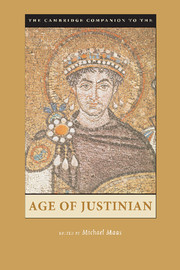Book contents
- Frontmatter
- Part 1 Structures and Ideologies of Empire
- 1 Roman Questions, Byzantine Answers
- 2 Economy and Administration
- 3 Justinian’s Constantinople
- 4 The Classical City in the Sixth Century
- 5 The Empire at War
- 6 Mediterranean Plague in the Age of Justinian
- 7 Law and Legal Practice in the Age of Justinian
- 8 Justinianic Ideology and the Power of the Past
- Part 2 Religion and Philosophy
- Part 3 Literature and the Arts
- Part 4 Peoples and Communities
- Bibliography
- Index
- Plate Section 1
- Plate Section 2
7 - Law and Legal Practice in the Age of Justinian
from Part 1 - Structures and Ideologies of Empire
Published online by Cambridge University Press: 28 May 2006
- Frontmatter
- Part 1 Structures and Ideologies of Empire
- 1 Roman Questions, Byzantine Answers
- 2 Economy and Administration
- 3 Justinian’s Constantinople
- 4 The Classical City in the Sixth Century
- 5 The Empire at War
- 6 Mediterranean Plague in the Age of Justinian
- 7 Law and Legal Practice in the Age of Justinian
- 8 Justinianic Ideology and the Power of the Past
- Part 2 Religion and Philosophy
- Part 3 Literature and the Arts
- Part 4 Peoples and Communities
- Bibliography
- Index
- Plate Section 1
- Plate Section 2
Summary
The vain titles of the victories of Justinian are crumbled into dust; but the name of the legislator is inscribed on a fair and everlasting monument. Under his reign, and by his care, the civil jurisprudence was digested in the immortal works of the Code, the Pandects [or Digest[, and the Institutes: the public reason of the Romans has been silently or studiously transfused into the domestic institutions of Europe, and the laws of Justinian still command the respect or obedience of independent nations.
– Edward Gibbon, The Decline and Fall of the Roman Empire, Chap. 44According to Edward Gibbon, writing in the late eighteenth century, the most important legacy of the Age of Justinian and indeed the most important legacy of the emperor himself lay in the field of law. Gibbon’s assessment still rings true. Though the physical boundaries of medieval Europe were recast repeatedly on battlefields long after the Age of Justinian had ended, the law issued in his name still shapes legal culture today.
The “fair and everlasting monument” Justinian bequeathed to posterity is known today as the Corpus iuris civilis: three codices or books of law, promulgated between the years 529 and 534. The Justinianic Codex, the Digest (or Pandects), and the Institutes sought to harmonize 1,000 years of complex and checkered development in the citizen law of the Romans. Justinian’s new law books contained old wine in new skins; each book utilized and incorporated different types of legal source material from the Roman past, but each also reshaped that material, harmonizing disparate texts with each other, mapping the outline of a system of law in a single body (corpus) of interlocking texts.
- Type
- Chapter
- Information
- The Cambridge Companion to the Age of Justinian , pp. 161 - 184Publisher: Cambridge University PressPrint publication year: 2005
- 10
- Cited by



